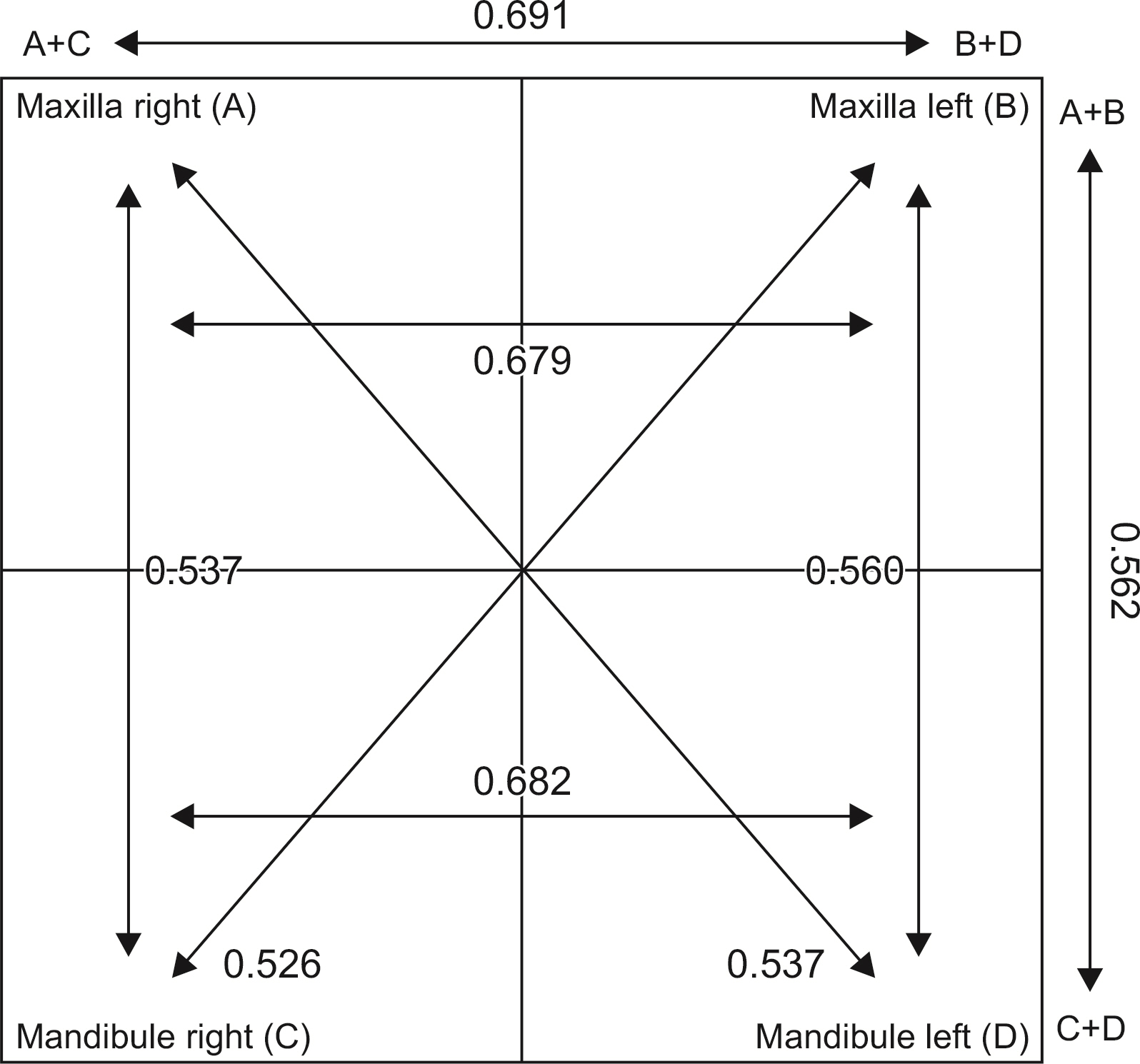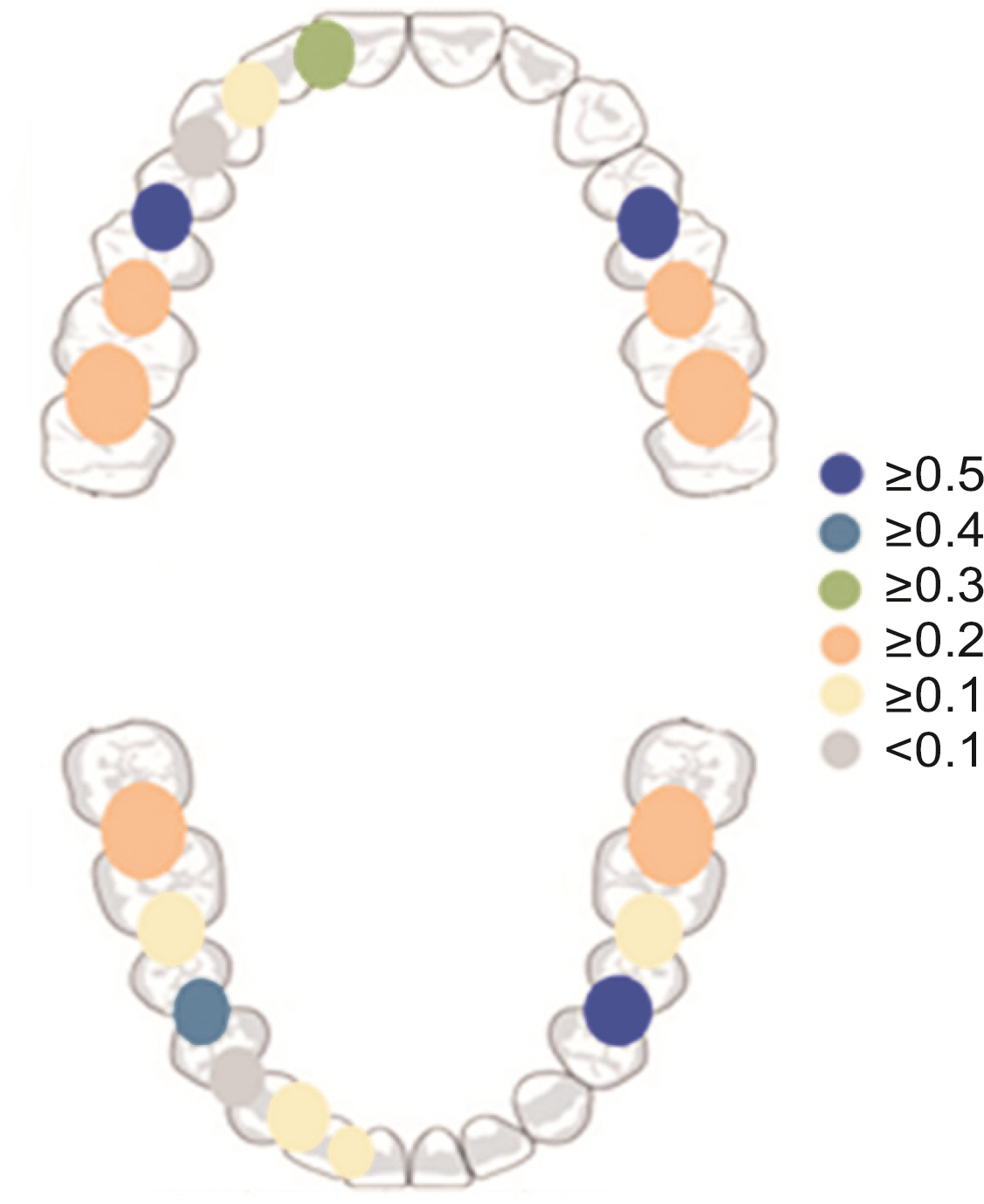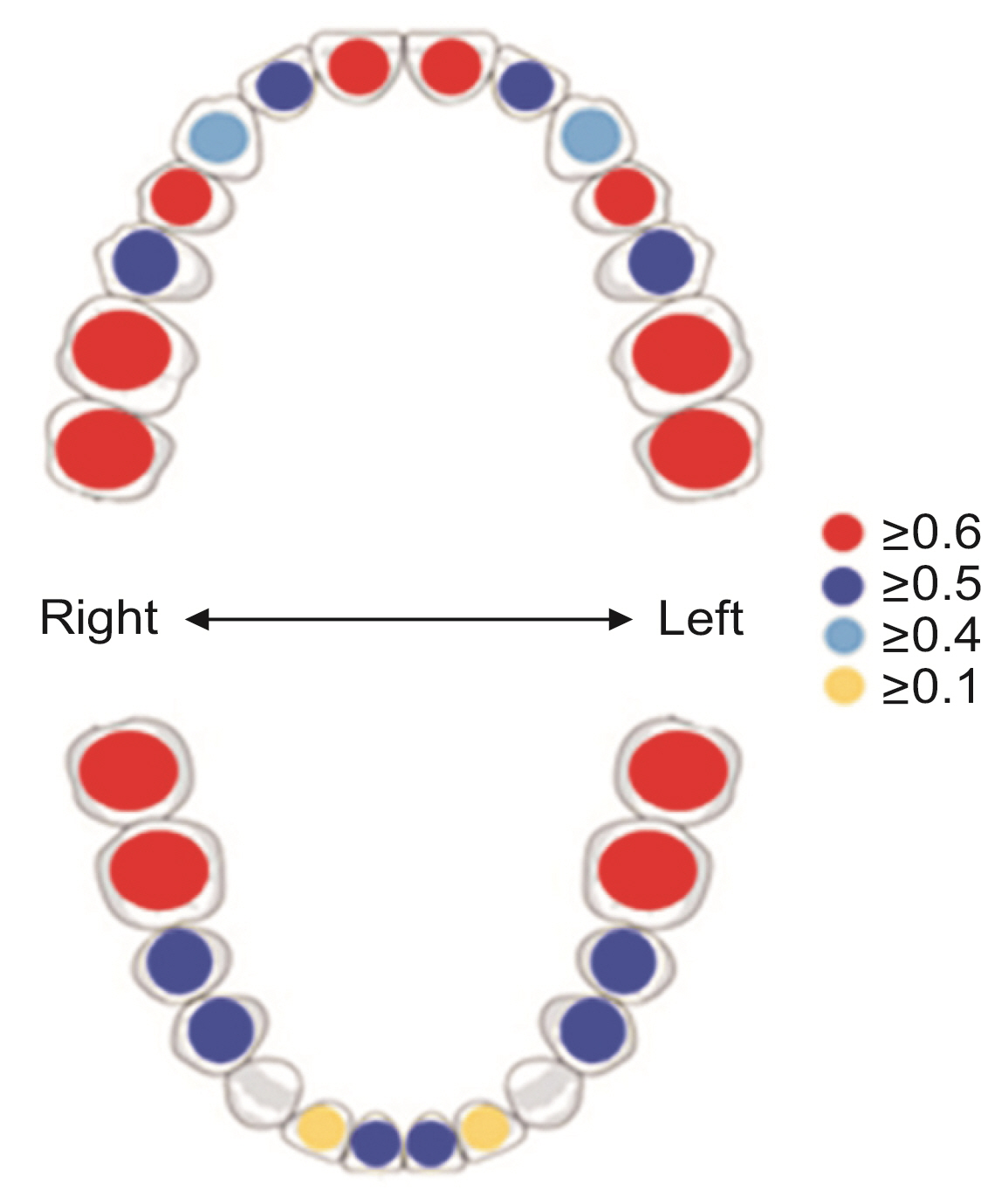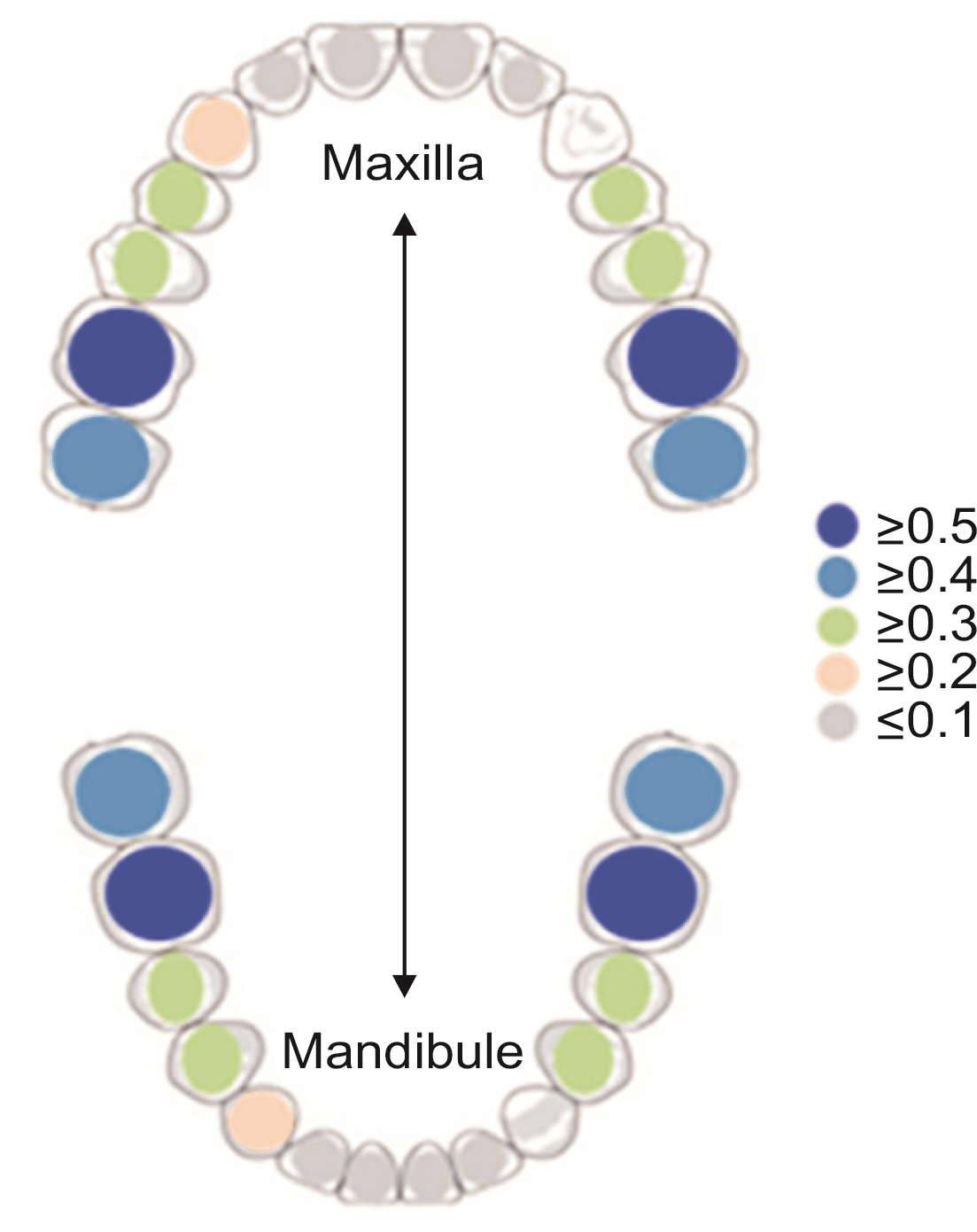J Korean Acad Oral Health.
2023 Jun;47(2):80-84. 10.11149/jkaoh.2023.47.2.80.
Dental caries incidence in permanent teeth of 12-year-old children in Korea
- Affiliations
-
- 1Department of Dental Hygiene, Yeoju Institute of Technology, Yeoju, Korea
- 2Department of Preventive and Public Health Dentistry, College of Dentistry, Wonkwang University, Iksan, Korea
- 3Institute of BiomaterialsㆍImplant (WBMI) and Institute of Wonkwang Dental Research, Wonkwang University, Iksan, Korea
- KMID: 2543914
- DOI: http://doi.org/10.11149/jkaoh.2023.47.2.80
Abstract
Objectives
The objective of this study was to analyze dental caries incidence in the permanent teeth of 12-year-old children.
Methods
This study used the raw data from the 2015 Korean children’s oral health survey. Participants of the research were 12-year-old children in their first year of middle school. A total of 27,291 people participated in the questionnaire and oral examination. Statistical analysis was performed using complex samples frequency analysis and contingency coefficient phi (φ).
Results
Dental caries predominately developed symmetrically with a higher tendency for left-right symmetry than for maxillary-mandibular symmetry in the mouth. The incidence of dental caries between adjacent teeth had a statistically significant correlation and was highest in the first and second premolars.
Conclusions
Information on symmetry in the development of dental caries and the association of dental caries incidence between adjacent teeth of 12-year-old children should be actively utilized when establishing evidence-based dental caries management plans.
Figure
Reference
-
References
1. WHO. Global DMFT for 12-year-olds : 2015. [Internet]. http://www.mah.se/CAPP/Country-Oral-Health-Profiles/According-to-Alphabetical/Global-DMFT-for-12-year-olds-2011/. cited 2017 July 19.2. Batchelor PA, Sheiham A. 2004; Grouping of tooth surfaces by susceptibility to caries: a study in 5-16 year-old children. BMC Oral Health. 4:2. DOI: 10.1186/1472-6831-4-2. PMID: 15511295. PMCID: PMC526778. PMID: a5dedcfc3b2e43429a47a7a5a97c4c9c.
Article3. Burnside G, Pine CM, Williamson PR. 2008; Modelling the bilateral symmetry of caries incidence. Caries Res. 42:291–296. DOI: 10.1159/000148161. PMID: 18663298.
Article4. Vanobbergen J, Lesaffre E, García-Zattera MJ, Jara A, Martens L, Declerck D. 2007; Caries patterns in primary dentition in 3-, 5- and 7-year-old children: spatial correlation and preventive consequences. Caries Res. 41:16–25. DOI: 10.1159/000096101. PMID: 17167255.
Article5. Loesche WJ, Eklund S, Earnest R, Burt B. 1984; Longitudinal investigation of bacteriology of human fissure decay: epidemiological studies in molars shortly after eruption. Infect Immun. 46:765–772. DOI: 10.1128/iai.46.3.765-772.1984. PMID: 6500709. PMCID: PMC261611.
Article6. Milnes AR, Bowden GH. 1985; The microflora associated with developing lesions of nursing caries. Caries Res. 19:289–297. DOI: 10.1159/000260858. PMID: 3861249.
Article7. Boue D, Armau E, Tiraby G. 1987; A bacteriological study of rampant caries in children. J Dent Res. 66:23–28. DOI: 10.1177/00220345870660010501. PMID: 3476538.
Article8. Chhour KL, Nadkarni MA, Byun R, Martin FE, Jacques NA, Hunter N. 2005; Molecular analysis of microbial diversity in advanced caries. J Clin Microbiol. 43:843–849. DOI: 10.1128/JCM.43.2.843-849.2005. PMID: 15695690. PMCID: PMC548050.
Article9. Aas JA, Griffen AL, Dardisc SR, Lee AM, Olsen I, Dewhirst FE, et al. 2008; Bacteria of dental caries in primary and permanent teeth in children and young adults. J Clin Microbiol. 46:1407–1417. DOI: 10.1128/JCM.01410-07. PMID: 18216213. PMCID: PMC2292933.
Article10. Mantzourani M, Gilbert SC, Sulong HN, Sheehy EC, Tank S, Fenlon M, Beighton D. 2009; The isolation of bifidobacteria from occlusal carious lesions in children and adults. Caries Res. 43:308–313. DOI: 10.1159/000222659. PMID: 19494490.
Article11. Lee KH, Ra JY, An SY, Kim YH. 2010; Degree of symmetry of dental caries in primary dentition. J Korean Acad Pediatr Dent. 37:453–460.12. Jung SS, Ju HJ, Lee HS. 2015; Dental caries experience pattern in permanent dentition among Korean adolescents. J Korean Acad Oral Health. 39:134–144. DOI: 10.11149/jkaoh.2015.39.2.134.
Article13. Kim IJ, Ju HJ, Lee SH, Lee HS. 2015; Patterns of dental caries experience on tooth surface in Korean adolescents. J Korean Acad Oral Health. 39:251–258. DOI: 10.11149/jkaoh.2015.39.4.251.
Article
- Full Text Links
- Actions
-
Cited
- CITED
-
- Close
- Share
- Similar articles
-
- The analysis of the risk factors for dental caries in Korean children and adolescents: a cross-sectional study
- Dental caries experience pattern in permanent dentition among Korean adolescents
- A study on the significant caries (SiC) index of Lao students
- The utility of dental health capacity of the first permanent molars as an oral health indicator among children and adolescents
- Classification of dental caries pattern in 12-year-old Korean adolescents by multivariate analysis





